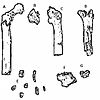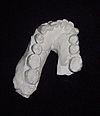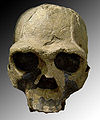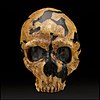Lys fossiele in die menslike evolusie
Die volgende lys fossiele in die menslike evolusie bevat fossiele van die tribus Hominini, wat in die Laat Mioseen (sowat 6 miljoen jaar gelede) ontstaan het. Aangesien duisende fossiele reeds gevind is, dikwels net enkele bene of tande,[1] is dit nie ’n volledige lys nie, maar dit bevat van die belangrikste vondste. Die fossiele is in die volgorde van oud tot jonk, soos bepaal deur radiometriese en/of inkrementele datering.
Die meeste van die fossiele word nie beskou as direkte voorouers van Homo sapiens nie, maar is nou verwant aan direkte voorouers en dus belangrik in die bestudering van die menslike lyn.
Laat Mioseen
[wysig | wysig bron]7 miljoen – 5,3 miljoen jaar oud
[wysig | wysig bron]| Foto | Naam | Ouderdom (jaar) | Spesie | Jaar ontdek |
Land | Ontdek deur |
|---|---|---|---|---|---|---|

|
TM 266 (Toumaï) | 7 miljoen[2] | Sahelanthropus tchadensis | 2001 | Tsjad | Alain Beauvilain, Fanone Gongdibe, Mahamat Adoum, Ahounta Djimdoumalbaye |

|
BAR 1000'00 | 6 miljoen[3] | Orrorin tugenensis | 2000 | Kenia | Martin Pickford, Kiptalam Cheboi, Dominique Gommery, Pierre Mein, Brigitte Senut |
Plioseen
[wysig | wysig bron]5,3 miljoen – 2,58 miljoen jaar oud
[wysig | wysig bron]| Foto | Naam | Ouderdom (jaar) | Spesie | Jaar ontdek |
Land | Ontdek deur |
|---|---|---|---|---|---|---|

|
Ardi | 4,4 miljoen[4] | Ardipithecus ramidus | 1994 | Ethiopië | Yohannes Haile-Selassie |
| KNM-LT 329 | 4,2 - 5 miljoen[5] | Australopithecus anamensis | 1967 | Kenia | Arnoud Lewis, Bryan Patterson[6][7] | |
| KNM-TH 13150 | 4,15-5,25 miljoen[8] | Australopithecus anamensis | 1984 | Kenia | Kiptalam Cheboi[6] | |
| KNM-KP 271 | 4 miljoen[9] | Australopithecus anamensis | 1965 | Kenia | Bryan Patterson[6] | |
| Laetoli-voetspore | 3,7 miljoen | Bipedale hominied | 1976 | Tanzanië | Mary Leakey | |
| LH 4 | 2,9 – 3,9 miljoen | Australopithecus afarensis | 1974 | Tanzanië | Donald Johanson[10] | |
| K 12 (Abel) | 3,5 miljoen | Australopithecus bahrelghazali | 1995 | Tsjad | Michel Brunet | |

|
Platgesigmens[11] | 3,5 miljoen | Kenyanthropus platyops | 1999 | Kenia | Justus Erus en Meave Leakey[12] |

|
Stw 573 (Kleinvoet) | 3,3 miljoen | Australopithecus ? | 1994 | Suid-Afrika | Ronald J. Clarke |

|
DIK-1 (Selam) | 3,3 miljoen | Australopithecus afarensis | 2000 | Ethiopië | Zeresenay Alemseged |

|
AL 288-1 (Lucy) | 3,2 miljoen | Australopithecus afarensis | 1974 | Ethiopië | Tom Gray, Donald Johanson, Yves Coppens en Maurice Taieb |
| AL 200-1 | 3 – 3,2 miljoen | Australopithecus afarensis | 1975 | Ethiopië | Donald Johanson, Yves Coppens en Maurice Taieb | |
| AL 129-1 | 3 – 3,2 miljoen | Australopithecus afarensis | 1973 | Ethiopië | Donald Johanson | |
| Foto by Modern Human Origins Geargiveer 29 Augustus 2010 op Wayback Machine |
AL 444-2 | 3 miljoen | Australopithecus afarensis | 1991 | Ethiopië | Bill Kimbel |
Pleistoseen
[wysig | wysig bron]Vroeë Paleolitikum: 2,58 miljoen – 300 000
[wysig | wysig bron]Middel-Paleolitikum: 300 000 – 50 000 jaar oud
[wysig | wysig bron]Laat Paleolitikum: 50 000 – 10 000 jaar oud
[wysig | wysig bron]Holoseen
[wysig | wysig bron]Mesolitikum/Neolitikum: 10 000 – 5 000 jaar oud
[wysig | wysig bron]| Foto | Naam | Ouderdom (jaar) | Spesie | Jaar ontdek |
Land | Ontdek deur |
|---|---|---|---|---|---|---|
| La Brea-vrou | Sowat 10 000 | Homo sapiens | 1914 | VSA | ||

|
Combe Capelle | 9 600[33] | Homo sapiens | 1909 | Frankryk | O. Hauser |
| Cheddar-mens | 9 000 | 1903 | Brittanje | |||

|
Kow-moeras 1 | 9 000 - 13 000 | Homo sapiens | 1968 | Australië | A.G. Thorne |
| Afalou 13 | 8 000 - 12 000 | Homo sapiens | 1920 | Algerië | C. Arambourg | |
| Wadi Halfa 25 | 8 000 - 12 000 | Homo sapiens | 1963 | Soedan | G. Armelagos, E. Ewing, D. Greene | |
| Wadi Kubbaniya | 8 000 - 20 000 | Homo sapiens | 1982 | Egipte | Fred Wendorf | |

|
Minnesota-vrou | 7 800 - 8 000 | Homo sapiens | 1931 | Minnesota, VSA |
Albert Jenks |
| Lo 4b | 6 000 - 9 000 | Homo sapiens | 1965 | H. Robbins, B.M. Lynch | ||
| Tepexpan-mens | 5 000 - 11 000 | Homo sapiens | 1947 | Mexiko | Hellmut de Terra | |
| SDM 16704 | 4 900 – 11 800 | Homo sapiens | 1929 | VSA | M.J. Rogers |
Afkortings in fossielname
[wysig | wysig bron]- AL - Afar-driehoek, Ethiopië
- ARA-VP - Aramis Vertebrate Paleontology, Ethiopië
- BAR – Baringo-distrik, Kenia
- BOU-VP - Bouri Vertebrate Paleontology, Ethiopië
- D - Dmanisi, Georgië
- ER – Turkanameer, Kenia
- KGA - Konso-Gardula, Ethiopië
- KNM - Kenia Nasionale Museum
- KP - Kanapoi, Kenia
- LB - Liang Bua, Indonesië
- LH – Laetoli-hominied, Tanzanië
- NG - Ngandong, Indonesië
- OH – Olduvai-hominied, Tanzanië
- SK - Swartkrans, Suid-Afrika
- Sts, Stw - Sterkfontein, Suid-Afrika
- TM – Transvaal-museum, Suid-Afrika
- TM - Toros-Menalla, Tsjad
- WT – Turkanameer, Kenia
Verdere leesstof
[wysig | wysig bron]- Gibbons, Ann. The First Human: The Race to Discover our Earliest Ancestor. Anchor Books (2007). ISBN 978-1-4000-7696-3
- Hartwig, Walter, red. (2002. Herdruk 2004). The Primate Fossil Record. Cambridge University Press. ISBN 978-0-521-08141-2.
{{cite book}}: Gaan datum na in:|year=(hulp) - Johanson, Donald & Wong, Kate. Lucy's Legacy: The Quest for Human Origins. Three Rivers Press (2009). ISBN 978-0-307-39640-2
- Jones, Steve; Martin, Robert D.; Pilbeam, David R. (red.). (1994). The Cambridge Encyclopedia of Human evolution. Cambridge University Press. ISBN 978-0-521-46786-5.
{{cite book}}: AS1-onderhoud: meer as een naam (link) - Leakey, Richard & Lewin, Roger. Origins Reconsidered: In Search of What Makes us Human. Little, Brown and Company (1992). ISBN 0-316-90298-5
- Lewin, Roger. Bones of Contention: Controversies in the Search for Human Origins. Penguin Books (1987). ISBN 0-14-022638-9
Verwysings
[wysig | wysig bron]- ↑ "Prominent Hominid Fossils" (in Engels). Geargiveer vanaf die oorspronklike op 15 Oktober 2019. Besoek op 31 Augustus 2006.
- ↑ "Fossil Hominids: Toumai" (in Engels). Talkorigins.org. 31 Julie 2002. Geargiveer vanaf die oorspronklike op 18 Oktober 2019. Besoek op 15 Oktober 2012.
- ↑ "Bar 10200'" (in Engels). Smithsonian National Museum of Natural History. Geargiveer vanaf die oorspronklike op 10 November 2019. Besoek op 27 Julie 2012.
- ↑ Amos, Jonathan (1 Oktober 2009). "Fossil finds extend human story". BBC News (in Engels). Geargiveer vanaf die oorspronklike op 25 Augustus 2017.
- ↑ I. A. N., McDougall; Craig, Feibel (1999). "Numerical age control for the Miocene-Pliocene succession at Lothagam, a hominoid-bearing sequence in the northern Kenya Rift". Journal of the Geological Society. 156: 731–745. doi:10.1144/gsjgs.156.4.0731.
- ↑ 6,0 6,1 6,2 Andrew Hill & Steven Ward (1988). "Origin of the Hominidae: The Record of African Large Hominoid Evolution Between 14 My and 4 My". Yearbook of Physical Anthropology. 31 (59): 49–83. doi:10.1002/ajpa.1330310505Sjabloon:Inconsistent citations
{{cite journal}}: CS1 maint: postscript (link) - ↑ Bryan Patterson, Anna K. Behrensmeyer, & William D. Sill (6 Junie 1970). "Geology and Fauna of a New Pliocene Locality in North-western Kenya". Nature. 226 (5249): 918–921. doi:10.1038/226918a0. PMID 16057594Sjabloon:Inconsistent citations
{{cite journal}}: AS1-onderhoud: meer as een naam (link) CS1 maint: postscript (link) Key details from select sources - ↑ Ward, Steven; Hill, Andrew. "Pliocene hominid partial mandible from Tabarin, Baringo, Kenya". American Journal of Physical Anthropology. 72 (1): 21–37. doi:10.1002/ajpa.1330720104.
- ↑ "Sorry, We Can't Find That Page - Search MSU" (in Engels). Msu.edu. Geargiveer vanaf die oorspronklike op 5 Augustus 2012. Besoek op 15 Oktober 2012.
- ↑ "Oldupai". Ntz.info. Besoek op 15 Oktober 2012.
- ↑ "KNM-WT 40000". Geargiveer vanaf die oorspronklike op 10 November 2013. Besoek op 1 Maart 2014.
- ↑ Smithsonian
- ↑ "argiefkopie". Geargiveer vanaf die oorspronklike op 5 Oktober 2012. Besoek op 1 Maart 2014.
- ↑ Jonathan, Amos (8 September 2011). "African fossils put new spin on human origins story". Science Mag (in Engels). BBC News. Geargiveer vanaf die oorspronklike op 18 Junie 2019. Besoek op 9 September 2011.
- ↑ Mai, L.L., Owl, M.Y., & Kersting, M.P. (2005), p.286
- ↑ 16,0 16,1 16,2 Meave G. Leakey, Fred Spoor, M. Christopher Dean, Craig S. Feibel, Susan C. Antón, Christopher Kiarie & Louise N. Leakey. 2012. New fossils from Koobi Fora in northern Kenya confirm taxonomic diversity in early Homo. Nature 488, 201–204 (9 August 2012) doi:10.1038/nature11322
- ↑ "Inverted strata". Geargiveer vanaf die oorspronklike op 2 Oktober 2006. Besoek op 1 Maart 2014.
- ↑ Donald C. Johanson, Blake Edgar (1996). From Lucy to Language. New York, NY: Simon & Schuster. p. 158.
- ↑ Michael Hopkin (26 Maart 2008). "Fossil find is oldest European yet". Nature News. doi:10.1038/news.2008.691.
- ↑ http://archive.archaeology.org/9809/newsbriefs/eritrea.html
- ↑ By ʻAlī Jāvīd, "World Heritage Monuments and Related Edifices in India, Volume 2", Page. 17
- ↑ P. Brown Dali archaic Homo Sapiens Geargiveer 6 Desember 2013 op Wayback Machine University of New England, Australië
- ↑ 23,00 23,01 23,02 23,03 23,04 23,05 23,06 23,07 23,08 23,09 Smith, T. M. (2010). "Dental evidence for ontogenetic differences between modern humans and Neanderthals". Proceedings of the National Academy of Sciences. 107 (49): 20923–20928. doi:10.1073/pnas.1010906107.
{{cite journal}}: Onbekende parameter|coauthors=geïgnoreer (hulp) - ↑ "Qafzeh IX". Geargiveer vanaf die oorspronklike op 27 September 2007. Besoek op 1 Maart 2014.
- ↑ Christopher J. Norton and David R. Braun. Asian paleanthropology: From Africa to China and beyond. New York, NY: Springer. p. 107. doi:10.1007/978-90-481-9094-2. ISBN 978-9048190935.
- ↑ "What does it mean to be human?". Smithsonian National Museum of Natural History. Geargiveer vanaf die oorspronklike op 5 Maart 2021. Besoek op 27 Julie 2012.
- ↑ "Human evolution: interpreting evidence". Museum of Science, Boston, US. Geargiveer vanaf die oorspronklike op 2 Mei 2004. Besoek op 27 Julie 2012.
- ↑ Timeline at Bone & Stone
- ↑ Robin McKie, science editor (20 Junie 2010). "Bones from a Cheddar Gorge cave show that cannibalism helped Britain's earliest settlers survive the ice age | Science | The Observer" (in Engels). Guardian. Geargiveer vanaf die oorspronklike op 9 Desember 2012. Besoek op 15 Oktober 2012.
{{cite web}}:|author=has generic name (hulp) - ↑ "Mystery of a West African skull from 13,000 jaar ago". Natural History Museum, London, UK. Besoek op 27 Julie 2012.[dooie skakel]
- ↑ Travels and Archeology in South Chile. Cornell University, New York, U.S. Besoek op 21 Augustus 2013.
- ↑ Storm, Paul; Nelson, Andrew (1992). "The many faces of Wadjak man". Archaeology Oceania. 27 (1): 37–46.
- ↑ Seidler, Christoph (9 Februarie 2011). "Forscher entzaubern Steinzeitmann". Der Spiegel (in Duits). Geargiveer vanaf die oorspronklike op 29 Januarie 2012. Besoek op 19 April 2012.
Ander bronne
[wysig | wysig bron]- Tattersall, Ian, Schwartz, Jeffery (2000). Extinct Humans. Westview Press, Boulder CO. ISBN 978-0-8133-3482-0.
{{cite book}}: AS1-onderhoud: meer as een naam (link) - Larsen, Clark Spencer, Matter, Robert M, Gebo, Daniel L (1991). Human Origins: the fossil record. Waveland Press, Prospect Heights, IL. ISBN 978-0-88133-575-0.
{{cite book}}: AS1-onderhoud: meer as een naam (link) - "Smithsonian Human Origins Program". Besoek op 29 Augustus 2006.
- "Prominent Hominid Fossils". Besoek op 31 Augustus 2006.
- Grine, F.E.; Jungers, W.L.; Schultz, J. (1996). "Phenetic Affinities Among Early Homo Crania from East and South Africa". Journal of Human Evolution. 30 (3): 189–225. doi:10.1006/jhev.1996.0019.






























